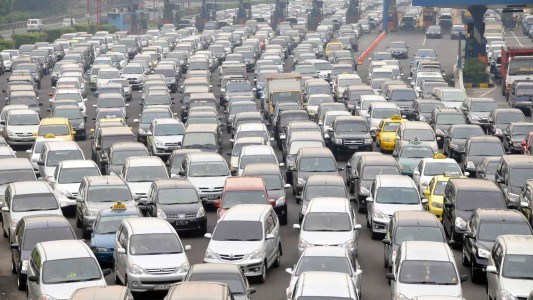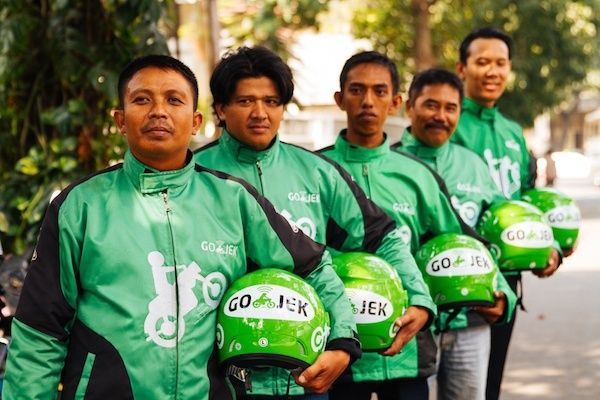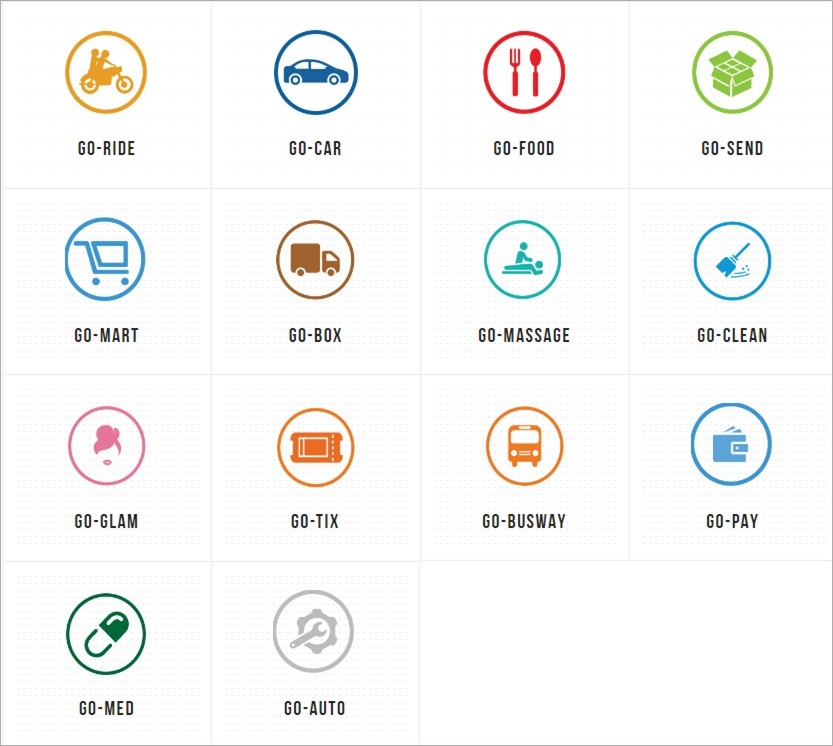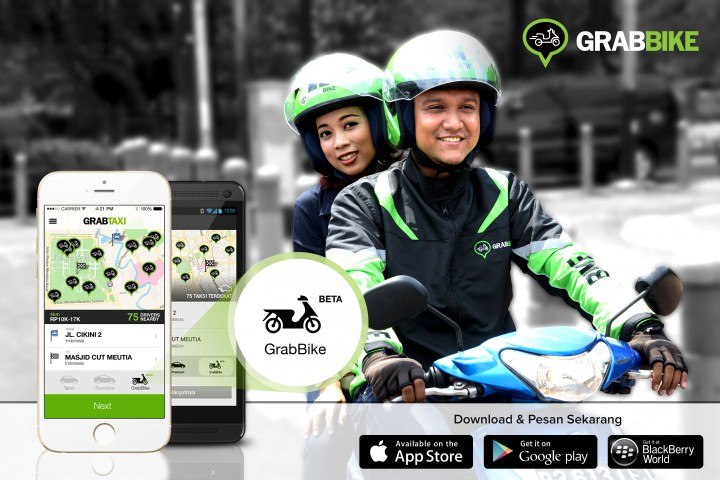GO-JEK: Motorbike taxi changing the landscape in Indonesia

GO-JEK, an Indonesian start up founded by HBS alum Nadiem Makarim (MBA 2011), became a unicorn at a US$1.3 billion valuation only 1.5 years after they launched its mobile application [1]. How did Makarim create such a huge business with digital technology?
 GO-JEK is a ride-sharing and on-demand services with motorbike taxi (“Ojek” in Indonesian language). Using the app, customers can find a motorbike driver for riding and other services. The app has been downloaded 25 million times [2], and processed 667,000 booking requests per day in June 2016 [3]. What makes GO-JEK so successful in Indonesia? Isn’t it just a copy cat of Uber with motorbike? There are three factors that make this business model so powerful.
GO-JEK is a ride-sharing and on-demand services with motorbike taxi (“Ojek” in Indonesian language). Using the app, customers can find a motorbike driver for riding and other services. The app has been downloaded 25 million times [2], and processed 667,000 booking requests per day in June 2016 [3]. What makes GO-JEK so successful in Indonesia? Isn’t it just a copy cat of Uber with motorbike? There are three factors that make this business model so powerful.
 First, GO-JEK is trying to solve one of the biggest headache in Indonesia – traffic congestion. Jakarta, the capital city with population around 10 million, was ranked as the worst city for traffic stops and starts (33,240 times a year on average – more than twice the number in New York) [4]. The average driver can only drive 8.3 km per hour, half of New York drivers [5]. In such an
First, GO-JEK is trying to solve one of the biggest headache in Indonesia – traffic congestion. Jakarta, the capital city with population around 10 million, was ranked as the worst city for traffic stops and starts (33,240 times a year on average – more than twice the number in New York) [4]. The average driver can only drive 8.3 km per hour, half of New York drivers [5]. In such an
environment, motorbike is the fastest way to move around the city, by zipping in and out of the traffic jams. In my personal experience, it only takes 15-20 min to travel by GO-JEK compared to more than 1 hour by taxi with the same distance during the rush hour.
 Secondly, GO-JEK is creating employment of the country. The number of GO-JEK drivers, 800 when they launched its app in 2015, has now increased more than 240,000 across Indonesia [6], almost three-fourths of Uber’s active drivers in U.S. [7]. Although many of them were Ojek drivers before GO-JEK started, their life has changed dramatically. They used to be idle for seventy-five percent of their time, but now their businesses have become much more efficient with GO-JEK – some said their salaries doubled [8]. Now the drivers with green jackets and helmets were one of the symbols in Jakarta.
Secondly, GO-JEK is creating employment of the country. The number of GO-JEK drivers, 800 when they launched its app in 2015, has now increased more than 240,000 across Indonesia [6], almost three-fourths of Uber’s active drivers in U.S. [7]. Although many of them were Ojek drivers before GO-JEK started, their life has changed dramatically. They used to be idle for seventy-five percent of their time, but now their businesses have become much more efficient with GO-JEK – some said their salaries doubled [8]. Now the drivers with green jackets and helmets were one of the symbols in Jakarta.
 Lastly, GO-JEK is not only about ride-sharing. They provide a wide range of delivery, not only of goods (food, parcel, medicine, movie tickets) but also services (cleaning, massage, hair styling, nail care, auto repair). These services are enabled by low labor cost in Indonesia, maintaining the competitive prices for customers. They also provide payment methods considering the local needs. Operating in the country where credit card penetration rate is less than 10% [9], GO-JEK offers two methods to customers: cash on delivery and GO-PAY, in which customers can pay without cash. They only need to top up the balance through either ATMs or internet/mobile banking. Travis Kalanick, Founder and CEO of Uber, envisions the world with “all the other goods and services that you could one day get delivered quickly, safely, with just the single touch of a button” [10]. For now, GO-JEK is ahead of Uber to achieve his vision.
Lastly, GO-JEK is not only about ride-sharing. They provide a wide range of delivery, not only of goods (food, parcel, medicine, movie tickets) but also services (cleaning, massage, hair styling, nail care, auto repair). These services are enabled by low labor cost in Indonesia, maintaining the competitive prices for customers. They also provide payment methods considering the local needs. Operating in the country where credit card penetration rate is less than 10% [9], GO-JEK offers two methods to customers: cash on delivery and GO-PAY, in which customers can pay without cash. They only need to top up the balance through either ATMs or internet/mobile banking. Travis Kalanick, Founder and CEO of Uber, envisions the world with “all the other goods and services that you could one day get delivered quickly, safely, with just the single touch of a button” [10]. For now, GO-JEK is ahead of Uber to achieve his vision.
 GO-JEK has also been facing challenges – competition. The biggest competitor of GO-JEK is Grab, a ride hailing start-up also founded by HBS alumni Anthony Tan and Hooi Ling Tang (both MBA 2011). Operating in 30 cities across Southeast Asia, Grab is expanding its business aggressively into the biggest country in the region. Recently Grab started GrabHitch, a service that offers ride sharing on motorcycles. With the similar concept to UberPool, Grab is trying to capture customers and drivers from GO-JEK. Uber is also a huge threat for GO-JEK. In order to adopt the market, Uber launched a motorbike service, UberMoter, and started offering cash payment option as well.
GO-JEK has also been facing challenges – competition. The biggest competitor of GO-JEK is Grab, a ride hailing start-up also founded by HBS alumni Anthony Tan and Hooi Ling Tang (both MBA 2011). Operating in 30 cities across Southeast Asia, Grab is expanding its business aggressively into the biggest country in the region. Recently Grab started GrabHitch, a service that offers ride sharing on motorcycles. With the similar concept to UberPool, Grab is trying to capture customers and drivers from GO-JEK. Uber is also a huge threat for GO-JEK. In order to adopt the market, Uber launched a motorbike service, UberMoter, and started offering cash payment option as well.
 Similar to ride-sharing services in other countries, government regulation is also a challenge. In December 2015, the Transport Ministry issued a letter to ban taxi and motorcycle hailing apps operating in the country [12]. Luckily, Joko Widodo, President of Indonesia, slammed the Transportation Ministry’s move and the Ministry withdrew the letter one day later [13]. However, given there has been ongoing complaints from the taxi industry, GO-JEK needs to watch out the moves.
Similar to ride-sharing services in other countries, government regulation is also a challenge. In December 2015, the Transport Ministry issued a letter to ban taxi and motorcycle hailing apps operating in the country [12]. Luckily, Joko Widodo, President of Indonesia, slammed the Transportation Ministry’s move and the Ministry withdrew the letter one day later [13]. However, given there has been ongoing complaints from the taxi industry, GO-JEK needs to watch out the moves.
So where GO-JEK should move going forward? I suggest three action plans:
- Expand within and beyond Indonesia: GO-JEK has already expanded its business into major cities in Indonesia, but still haven’t started their operations in tier 2 cities. Ojek is still common in those cities, so GO-JEK should have opportunities there. Also, this business model is applicable to other emerging markets as well, such as Vietnam and India. In order to meet the investors’ expectations, GO-JEK should explore aggressive expansion plan
- Keep testing new service lines: I believe the real strength of GO-JEK is a wide range of service lines – this enables them to be a partner for every aspect of the customers’ lives. Some of the services may not work, but it is important for them to keep testing new services to find the customer needs
- Lobbying to the government: The huge risk for GO-JEK is the government regulation. Especially in emerging countries like Indonesia, the government policies are unpredictable. Therefore it is crucial for GO-JEK to keep lobbying and developing relationships with the government, and to communicate how GO-JEK is making Indonesian society better
(Word Count: 797 words)
Endnotes:
- Pratama, Aditya Hadi. “Go-Jek: A unicorn’s journey (Infographic).” Tech in Asia, August 2016. https://www.techinasia.com/how-go-jek-became-unicorn.
- Marsh, Jenni. “How do you navigate a problem like Jakarta’s gridlock?.” CNN, August 2016. http://www.cnn.com/2016/08/03/asia/go-jek/
- Russel, John. “Indonesia’s Go-Jek raises $550 million to battle Uber and Grab.” Tech Crunch, August 2016. https://techcrunch.com/2016/08/04/indonesias-go-jek-raises-550-million-to-battle-uber-and-grab/
- Greenfield, Charlotte. “Expect delays: world’s-worst Jakarta traffic in gridlock for another decade.”, Reuters, April 2015. http://www.reuters.com/article/us-indonesia-traffic-idUSKBN0N806E20150417
- Ibid.
- Marsh, Jenni. “How do you navigate a problem like Jakarta’s gridlock?.” CNN, August 2016. http://www.cnn.com/2016/08/03/asia/go-jek/
- Carson, Biz. “Why there’s a good chance your Uber driver is new.”, Business Insider, October 2015. http://www.businessinsider.com/uber-doubles-its-drivers-in-2015-2015-10
- Hutton, Jeffery. “The Taxi Wars of Jakarta.”, Harvard Business School, September 2016. https://www.alumni.hbs.edu/stories/Pages/story-impact.aspx?num=5779
- Ibid.
- “ 5-Year Anniversary Remarks from Uber CEO Travis Kalanick.”, Uber, June 2015. https://newsroom.uber.com/5-years-travis-kalanick/
- Sambur, Hana. “Grab introduces UberPool-like ride sharing in Indonesia – but for motorcycles.”, Tech in Asia, October 2016. https://www.techinasia.com/grab-introduces-uberpoollike-ride-sharing-indonesia-motorcycles
- “Uber, Go-Jek Ban Targeted by Transport Ministry.”, Jakarta Globe, December 2015. http://jakartaglobe.id/business/uber-go-jek-ban-targeted-transport-ministry/
- “Jokowi defends ride-hailing apps as Transportation Ministry withdraws ban.”, The Jakarta Post, December 2015. http://www.thejakartapost.com/news/2015/12/18/jokowi-defends-ride-hailing-apps-transportation-ministry-withdraws-ban.html
Photo & Exhibit Credits:
Cover photo: Formation Group, November 2016. http://formationgroup.com/company/go-jek/
Picture 1: “Restoration of Jakarta Public Transport.”, Vacation Bali Indonesia, November 2016. http://www.vacationbaliindonesia.com/restoration-jakarta-public-transport/
Picture 2: “The rise of Jakarta’s app-based couriers: Ojek a-go-go!”, Insight Asia, June 2015. http://www.insightasia.com/blog/the-rise-of-jakartas-app-based-couriers-ojek-a-go-go
Picture 3: GO-JEK, November 2016. https://www.go-jek.com/
Picture 4: Tay, Danie. “GrabTaxi’s motorcycle service rides into its third city, offers free rides in Jakarta.”, Tech in Asia, May 2015. https://www.techinasia.com/grabtaxi-grabbike-motorcycle-service-jakarta
Picture 5: Malm, Sara. “Uber anger goes global: Jakarta’s taxi and tuktuk drivers protest ride-hailing apps causing chaos in Indonesian capital.”, Daily Mail.com, March 2016. http://www.dailymail.co.uk/news/article-3503902/Protest-against-taxi-apps-causes-chaos-Indonesia-capital.html



This was very interesting to read in the context of our recent Uber case. Indonesia definitely seems to represent some unique challenges with the congestion and very different infrastructure. That being said, they still seem to face some of the same dilemmas we saw with Uber. It will be very interesting to see the competitive environment between GO-Jek and Grab.
Thanks for a great article. I’m really interested on why Go-Jek did not expand as aggressively as Uber or Grab Taxi initially. It seems like scale is the key in these types of business models, and Go-Jek could potentially be displaced by competitors. I also wonder how scalable the motorcycle concept is in other parts of South Asia. While Grab and Uber went from cabs into motorcycles, I think it would require changes to the operating model if Go-Jek goes from motorcycles to cars in some of the other target markets.
I think Go-Pay is Go-Jek’s competitive advantage and how quickly they got adoption of digital money in the mainstream. Here’s an article where the CEO talks about this advantage in more detail: https://www.techinasia.com/go-jek-gopay-tipping-point. I wonder if there are other ways to leverage their digital money platform for other business lines (e.g. pay-as-you go financing for solar, healthcare, agriculture in rural areas).
Great article Taka. I am really fascinated with the fact that Go-Jek was able to influence the government into allowing it to continue operating. Kenya also faces the same concerns with traffic and motorcycles have become the fastest mode of public transportation. I wonder whether this would work there.
Taka, like you I am a huge fan of Go-Jek, having used it to get to the airport in Jakarta and for deliveries in Bali. My question is how do you think the insurance issues, which affect Uber come to affect Go-Jek. What happens if someone gets hurt on a Go-Jek? What happens if Go-Jek delivers alcohol to those under the age of 18? Does the (for now, lax) regulatory environment allow Go-Jek to exist, and do you think that Go-Jek can be so easily replicated overseas?